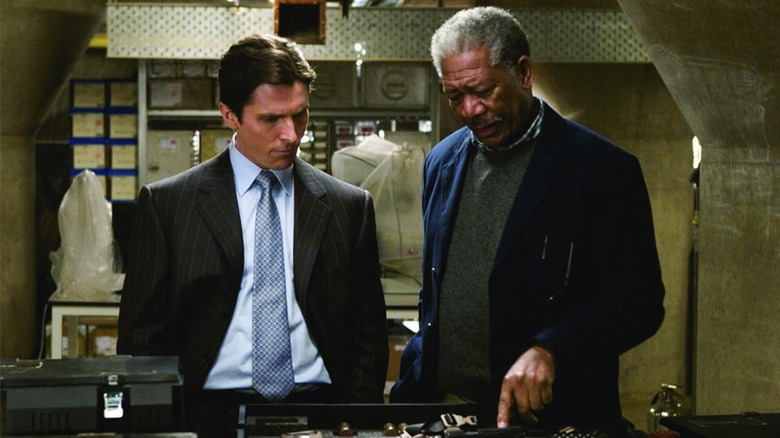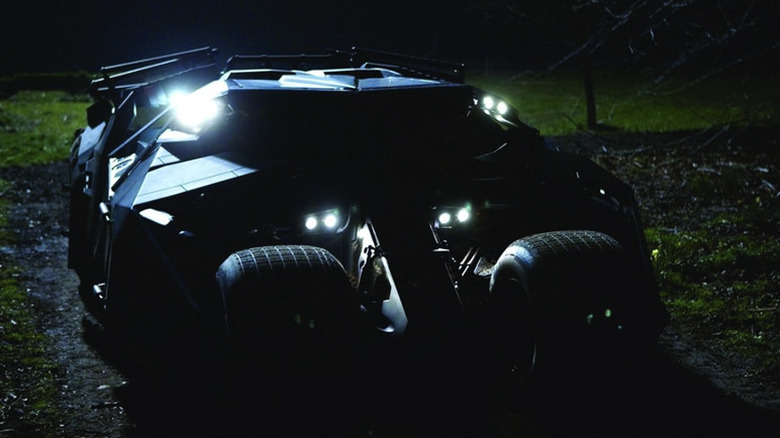How A Shameless Studio Note Helped Shape Christopher Nolan's Dark Knight Trilogy
When Warner Bros. asked Christopher Nolan if he had any ideas to resurrect the Batman franchise after "Batman & Robin" had taken the character to an extreme end of the cinematic spectrum, Nolan instantly knew what to do. "I saw it immediately," the director said in an interview featured in Tom Shone's 2020 book "The Nolan Variations: The Movies, Mysteries, and Marvels of Christopher Nolan."
"I was like, No, no, you have never done with Batman what you guys did with Superman in the seventies. The whole dig-down approach, where you submit it to this big production ethic, with all these name actors and faces, and throw it into reality — not in a gritty sense, but in an action-movie sense. What if this was as real as any other action movie? I just saw this gap in movie history."
WB executive Greg Silverman gave Nolan and his production partner (and wife) Emma Thomas some requirements before they got underway: "Batman Begins" had to be rated PG-13 instead of R so kids could see it in theaters, and after some thought, Silverman also added "it would be great if [Batman] had a very cool car." The latter note initially gave Nolan pause:
"I remember thinking, I don't know ... really? Can we make that work? I said, 'That's a huge challenge.' It wound up being the thing that we focused on, even as we were writing the script. It was like, where would it come from, what would it look like, how would we explain this in our telling? It actually wound up being the key to a lot of things. We were all about 'How do you sell the idea of a guy in a costume? What's the mythology? How do you justify it?'"
Not only did Nolan have to justify a guy beating up criminals while wearing a bat costume, he also had to justify a "very cool car" being introduced in the movie so the studio could make money on merchandising. For some directors, that might have been a "line in the sand" moment, a time to battle with the studio over the vision and integrity of the picture. But Nolan took the note in stride and let it inform his entire approach to making the trilogy (even though it wasn't originally conceived as a trilogy).
Christopher Nolan found a silver lining in a studio note for his Batman movies
In other interviews, Nolan has said he initially wasn't planning to include a version of The Batmobile in his film ("I had been assuming we would not deal with that at all, or that would be something that if somebody made sequels later on because it seems so fanciful"), but he and production designer Nathan Crowley ultimately worked out a design for something that could conceivably exist within the world they were creating, and the vehicle took center stage in a climactic chase across Gotham City.
Of course, the Tumbler eventually appeared in "The Dark Knight" (a movie that's even better than you remember) and received an even better showcase in that unforgettable moment of Batman bursting out of the damaged vehicle on the Batpod motorcycle. That moment serves as a graduation of sorts between films — a middle ground between the Tumbler and the Bat, the flying vehicle that would appear in 2012's "The Dark Knight Rises." All three vehicles were designed with realism in mind, but by the time the franchise progressed to "The Dark Knight Rises," the movie's bombastic requirements were pushing the limits of that grounded approach. (Once our hero starts zooming above the streets in what is effectively a flying car, the film starts to dip into zanier territory and makes it a bit more difficult for audiences to suspend their disbelief.)
Still, it's impressive that Nolan and his collaborators were able to fulfill such a blatantly commercial studio note in a way that not only felt organic to the story, but had an ethos which seeped into every other aspect of the Dark Knight trilogy.

